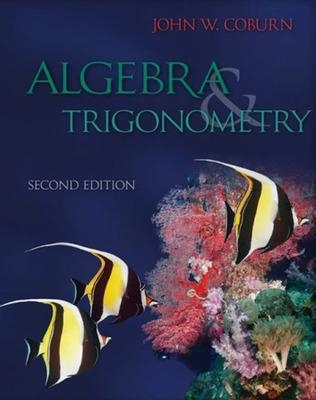
Algebra & Trigonometry
McGraw Hill Higher Education (Verlag)
978-0-07-727651-5 (ISBN)
Three components contribute to a theme sustained throughout the Coburn Series: that of laying a firm foundation, building a solid framework, and providing strong connections. Not only does Coburn present a sound problem-solving process to teach students to recognize a problem, organize a procedure, and formulate a solution, the text encourages students to see beyond procedures in an effort to gain a greater understanding of the big ideas behind mathematical concepts.
Written in a readable, yet mathematically mature manner appropriate for college algebra level students, Coburn’s Algebra & Trigonometry uses narrative, extensive examples, and a range of exercises to connect seemingly disparate mathematical topics into a cohesive whole. Coburn’s hallmark applications are born out of the author’s extensive experiences in and outside the classroom, and appeal to the vast diversity of students and teaching methods in this course area.
Benefiting from the feedback of hundreds of instructors and students across the country, Algebra & Trigonometry second edition, continues to emphasize connections in order to improve the level of student engagement in mathematics and increase their chances of success in college algebra.
John Coburn grew up in the Hawaiian Islands, the seventh of sixteen children. He received his Associate of Arts degree in 1977 from Windward Community College, where he graduated with honors. In 1979 he received a Bachelor’s Degree in Education from the University of Hawaii. After being lured into the business world for five years, he returned to his first love, accepting a teaching position in high school mathematics where he was recognized as Teacher of the Year in 1987. Soon afterward, the decision was made to seek a Masters Degree, which he received two years later from the University of Oklahoma. For the last fifteen years, he has been teaching mathematics at the Florissant Valley campus of St. Louis Community College, where he is now a full professor. During his tenure there he has received numerous nominations as an outstanding teacher by the local chapter of Phi Theta Kappa, two nominations to Who’s Who Among America’s Teachers and was recognized as Teacher of the year in 2004 by the Mathematics Educators of Greater St. Louis (MEGSL). He has made numerous presentations and local, state and national conferences on a wide variety of topics. His other loves include his family, music, athletics, games and all things beautiful, and hopes this love of life comes through in his writing, and serves to make the learning experience an interesting and engaging one for all students.
Chapter R: A Review of Basic Concepts and SkillsR-1The Language, Notation, and Numbers of MathematicsR-2Algebraic Expressions and the Properties of Real NumbersR-3Exponents, Scientific Notation, and a Review of PolynomialsR-4Factoring PolynomialsR-5Rational ExpressionsR-6Radicals and Rational ExponentsChapter 1: Equations and Inequalities1-1Linear Equations, Formulas, and Problem Solving1-2Linear Inequalities in One Variable1-3Absolute Value Equations and Inequalities1-4Complex Numbers1-5Solving Quadratic Equations1-6Solving Other Types of EquationsChapter 2: Relations, Functions and Graphs2-1Rectangular Coordinates; Graphing Circles and Relations2-2Graphs of Linear Equations2-3Linear Equations and Rates of Change2-4Functions, Notation, and Graphs of Functions2-5Analyzing the Graph of a Function2-6Toolbox Functions and Transformations2-7Piecewise-Defined Functions2-8The Algebra and Composition of FunctionsChapter 3: Polynomial and Rational Functions3-1Quadratic Functions and Applications3-2Synthetic Division; The Remainder and Factor Theorems3-3The Zeroes of Polynomial Functions3-4Graphing Polynomial Functions3-5Graphing Rational Functions3-6Additional Insights into Rational Functions3-7Polynomial and Rational Inequalities3-8Variation: Function Models in ActionChapter 4: Exponential and Logarithmic Functions4-1One-to-One and Inverse Functions4-2Exponential Functions4-3Logarithms and Logarithmic Functions4-4Properties of Logarithms; Solving Exponential and Logarithmic Equations4-5Applications from Business, Finance, and ScienceChapter 5: Introduction to Trigonometric Functions5-1Angle Measure, Special Triangles, and Special Angles5-2The Trigonometry of Right Triangles 5-3Trigonometry and the Coordinate Plane 5-4Unit Circles and the Trigonometric of Real Numbers5-5Graphs of Sine and Cosine Functions; Cosecant and Secant Functions 5-6Graphs of Tangent and Cotangent Functions 5-7Transformations and Applications of Trigonometric GraphsChapter 6: Trigonometric Identities, Inverses, and Equations6-1Fundamental Identities and Families of Identities 6-2Constructing and Verifying Identities 6-3The Sum and Difference Identities 6-4Double Angle, Half Angle & Product-to-Sum Identities6-5The Inverse Trigonometric Functions and Their Applications6-6Solving Basic Trigonometric Equations6-7General Trigonometric Equations and ApplicationsChapter 7: Applications of Trigonometry7-1Oblique Triangles and the Law of Sines 7-2The Law of Cosines; Area of a Triangle7-3Vectors and Vector Diagrams7-4Vector Applications and the Dot Product 7-5Complex Numbers in Trigonometric Form 7-6Demoivre’s Theorem and the Theorem on nth Roots Chapter 8: Systems of Equations and Inequalities8-1Linear Systems in Two Variables with Applications8-2Linear Systems in Three Variables with Applications8-3Nonlinear Systems of Equations and Inequalities8-4Systems of Inequalities and Linear ProgrammingChapter 9: Matrices and Matrix Applications9-1Solving Systems Using Matrices and Row Operations9-2The Algebra of Matrices9-3Solving Linear Systems Using Matrix Equations9-4Applications of Matrices and Determinants: Cramer's Rule, Partial Fractions, and More Chapter 10: Analytical Geometry and Conic Sections10-1 Introduction to Analytic Geometry10-2 The Circle and the Ellipse10-3 The Hyperbola10-4 The Analytic Parabola10-5 Polar Coordinates, Equations, and Graphs10-6 More on Conic Sections: Rotation of Axes and Polar Form10-7 Parametric Equations and GraphsChapter 11: Additional Topics in Algebra11-1 Sequences and Series11-2 Arithmetic Sequences11-3 Geometric Sequences11-4 Mathematical Induction11-5 Counting Techniques11-6 Introduction to Probability11-7 The Binomial TheoremSummary and Concept Review
APPENDICESA-1More on Synthetic DivisionA-2More on MatricesA-3Deriving the Equation of a ConicA-4Proof Positive - A Selection of Proofs from Algebra and Trigonometry
| Erscheint lt. Verlag | 16.3.2009 |
|---|---|
| Verlagsort | London |
| Sprache | englisch |
| Maße | 221 x 282 mm |
| Gewicht | 2677 g |
| Themenwelt | Mathematik / Informatik ► Mathematik ► Algebra |
| Mathematik / Informatik ► Mathematik ► Geometrie / Topologie | |
| ISBN-10 | 0-07-727651-5 / 0077276515 |
| ISBN-13 | 978-0-07-727651-5 / 9780077276515 |
| Zustand | Neuware |
| Informationen gemäß Produktsicherheitsverordnung (GPSR) | |
| Haben Sie eine Frage zum Produkt? |
aus dem Bereich


